Spatiotemporal Variation in NDVI in the Sunkoshi River Watershed During 2000–2021 and Its Response to Climate Factors and Soil Moisture
Abstract
1. Introduction
2. Materials and Methods
2.1. Study Area
2.2. Data Sources
2.3. Data Preprocess
- Simple linear trend (SLT) model
- Seasonal and trend decomposition using loess (STL) method
- Mann–Kendall test
- Partial correlation analysis
3. Results
3.1. Temporal Variation Characteristics of Vegetation in the Watershed
3.2. Spatial Variation Characteristics of Vegetation in the Watershed
3.3. Relationship Among NDVI and Climatic Factors and Soil Moisture
3.3.1. Partial Correlation Analysis Among NDVI and Climatic Factors and Soil Moisture over the Watershed
3.3.2. Spatial Heterogeneity of the Relationship Among NDVI and Climatic Factors and Soil Moisture
3.4. Lag and Cumulative Effects of Climate Factors and Soil Moisture on Vegetation
4. Discussion
4.1. Spatiotemporal Variation in the SKRW
4.2. The Dominant Driving Factors of NDVI Change
4.3. Lag and Cumulative Effects of Impact Factors on NDVI Response
4.4. The Limitation of This Study
5. Conclusions
Author Contributions
Funding
Data Availability Statement
Conflicts of Interest
References
- Zhu, Z.; Fu, Y.; Woodcock, C.E.; Olofsson, P.; Vogelmann, J.E.; Holden, C.; Wang, M.; Dai, S.; Yu, Y. Including land cover change in analysis of greenness trends using all available Landsat 5, 7, and 8 images: A case study from Guangzhou, China (2000–2014). Remote Sens. Environ. 2016, 185, 243–257. [Google Scholar] [CrossRef]
- Wu, C.; Venevsky, S.; Sitch, S.; Yang, Y.; Wang, M.; Wang, L.; Gao, Y. Present-day and future contribution of climate and fires to vegetation composition in the boreal forest of China. Ecosphere 2017, 8, e01917. [Google Scholar] [CrossRef]
- Przeździecki, K.M.; Zawadzki, J.; Cieszewski, C.; Bettinger, P. Estimation of soil moisture across broad landscapes of Georgia and South Carolina using the triangle method applied to MODIS satellite imagery. Silva Fenn. 2017, 51, 1683. [Google Scholar] [CrossRef]
- Bo-Tao, Z.; Jin, Q. Changes of weather and climate extremes in the IPCC AR6. Adv. Clim. Change Res. 2021, 17, 713. [Google Scholar]
- Yang, Q.; Zhang, H.; Peng, W.; Lan, Y.; Luo, S.; Shao, J.; Chen, D.; Wang, G. Assessing climate impact on forest cover in areas undergoing substantial land cover change using Landsat imagery. Sci. Total Environ. 2019, 659, 732–745. [Google Scholar] [CrossRef]
- He, L.; Guo, J.; Yang, W.; Jiang, Q.; Chen, L.; Tang, K. Multifaceted responses of vegetation to average and extreme climate change over global drylands. Sci. Total Environ. 2023, 858, 159942. [Google Scholar] [CrossRef]
- Li, P.; Wang, J.; Liu, M.; Xue, Z.; Bagherzadeh, A.; Liu, M. Spatio-temporal variation characteristics of NDVI and its response to climate on the Loess Plateau from 1985 to 2015. Catena 2021, 203, 105331. [Google Scholar] [CrossRef]
- Vrac, M.; Thao, S.; Yiou, P. Changes in temperature–precipitation correlations over Europe: Are climate models reliable? Clim. Dyn. 2023, 60, 2713–2733. [Google Scholar] [CrossRef]
- Li, W.; Chen, R.; Ma, D.; Wang, C.; Yang, Y.; Wang, C.; Chen, H.; Yin, G. Tracking autumn photosynthetic phenology on Tibetan plateau grassland with the green–red vegetation index. Agric. For. Meteorol. 2023, 339, 109573. [Google Scholar] [CrossRef]
- Stisen, S.; Sandholt, I.; Nørgaard, A.; Fensholt, R.; Eklundh, L. Estimation of diurnal air temperature using MSG SEVIRI data in West Africa. Remote Sens. Environ. 2007, 110, 262–274. [Google Scholar] [CrossRef]
- Liu, Y.; Li, Y.; Li, S.; Motesharrei, S. Spatial and temporal patterns of global NDVI trends: Correlations with climate and human factors. Remote Sens. 2015, 7, 13233–13250. [Google Scholar] [CrossRef]
- Chen, B.-M.; Gao, Y.; Liao, H.-X.; Peng, S.-L. Differential responses of invasive and native plants to warming with simulated changes in diurnal temperature ranges. AoB Plants 2017, 9, plx028. [Google Scholar] [CrossRef]
- Wu, H.; Xiong, D.; Liu, B.; Zhang, S.; Yuan, Y.; Fang, Y.; Chidi, C.L.; Dahal, N.M. Spatio-temporal analysis of drought variability using CWSI in the Koshi River Basin (KRB). Int. J. Environ. Res. Public Health 2019, 16, 3100. [Google Scholar] [CrossRef]
- Peng, S.S.; Chen, A.P.; Xu, L.; Cao, C.X.; Fang, J.Y.; Myneni, R.B.; Pinzon, J.E.; Tucker, C.J.; Piao, S.L. Recent change of vegetation growth trend in China. Environ. Res. Lett. 2011, 6, 044027. [Google Scholar] [CrossRef]
- Sun, H.; Wang, J.; Xiong, J.; Bian, J.; Jin, H.; Cheng, W.; Li, A.; Mozo, H.G. Vegetation change and its response to climate change in Yunnan Province, China. Adv. Meteorol. 2021, 2021, 8857589. [Google Scholar] [CrossRef]
- Liu, H.; Tian, F.; Hu, H.; Hu, H.; Sivapalan, M. Soil moisture controls on patterns of grass green-up in Inner Mongolia: An index based approach. Hydrol. Earth Syst. Sci. 2013, 17, 805–815. [Google Scholar] [CrossRef]
- Mohanty, B.P.; Skaggs, T. Spatio-temporal evolution and time-stable characteristics of soil moisture within remote sensing footprints with varying soil, slope, and vegetation. Adv. Water Resour. 2001, 24, 1051–1067. [Google Scholar] [CrossRef]
- Yang, L.; Wei, W.; Chen, L.; Chen, W.; Wang, J. Response of temporal variation of soil moisture to vegetation restoration in semi-arid Loess Plateau, China. Catena 2014, 115, 123–133. [Google Scholar] [CrossRef]
- Vreugdenhil, M.; Dorigo, W.A.; Wagner, W.; De Jeu, R.A.; Hahn, S.; Van Marle, M.J. Analyzing the vegetation parameterization in the TU-Wien ASCAT soil moisture retrieval. IEEE Trans. Geosci. Remote Sens. 2016, 54, 3513–3531. [Google Scholar] [CrossRef]
- Nandintsetseg, B.; Shinoda, M.; Kimura, R.; Ibaraki, Y. Relationship between soil moisture and vegetation activity in the Mongolian steppe. Sola 2010, 6, 29–32. [Google Scholar] [CrossRef]
- Li, W.; Migliavacca, M.; Forkel, M.; Denissen, J.M.C.; Reichstein, M.; Yang, H.; Duveiller, G.; Weber, U.; Orth, R. Widespread increasing vegetation sensitivity to soil moisture. Nat. Commun. 2022, 13, 3959. [Google Scholar] [CrossRef]
- Bajracharya, S.R.; Pradhananga, S.; Shrestha, A.B.; Thapa, R. Future climate and its potential impact on the spatial and temporal hydrological regime in the Koshi Basin, Nepal. J. Hydrol. Reg. Stud. 2023, 45, 101316. [Google Scholar] [CrossRef]
- Zhang, Y.; Gao, J.; Liu, L.; Wang, Z.; Ding, M.; Yang, X. NDVI-based vegetation changes and their responses to climate change from 1982 to 2011: A case study in the Koshi River Basin in the middle Himalayas. Glob. Planet. Change 2013, 108, 139–148. [Google Scholar] [CrossRef]
- Wu, X.; Sun, X.; Wang, Z.; Zhang, Y.; Liu, Q.; Zhang, B.; Paudel, B.; Xie, F. Vegetation changes and their response to global change based on NDVI in the Koshi river Basin of central Himalayas since 2000. Sustainability 2020, 12, 6644. [Google Scholar] [CrossRef]
- Banjara, P.; Pandey, V.P.; Shrestha, P.K. Drought Risk Assessment in Sunkoshi River Basin: An Application of Hydrological Model. In Proceedings of the 12th IOE Graduate Conference, Kathmandu, Nepal, 19–22 October 2022. [Google Scholar]
- Ehrlich, D.; Estes, J.E.; Singh, A. Applications of NOAA-AVHRR 1 km data for environmental monitoring. Remote Sens. 1994, 15, 145–161. [Google Scholar] [CrossRef]
- Ma, Y.; He, T.; McVicar, T.R.; Liang, S.; Liu, T.; Peng, W.; Song, D.-X.; Tian, F. Quantifying how topography impacts vegetation indices at various spatial and temporal scales. Remote Sens. Environ. 2024, 312, 114311. [Google Scholar] [CrossRef]
- Coll, C.; Caselles, V.; Galve, J.; Valor, E.; Niclos, R.; Sanchez, J.; Rivas, R. Ground measurements for the validation of land surface temperatures derived from AATSR and MODIS data. Remote Sens. Environ. 2005, 97, 288–300. [Google Scholar] [CrossRef]
- Peng, G.; Li, J.; Chen, Y.; Norizan, A.P.; Tay, L. High-resolution surface relative humidity computation using MODIS image in Peninsular Malaysia. Chin. Geogr. Sci. 2006, 16, 260–264. [Google Scholar] [CrossRef]
- Famiglietti, C.A.; Fisher, J.B.; Halverson, G.; Borbas, E.E. Global validation of MODIS near-surface air and dew point temperatures. Geophys. Res. Lett. 2018, 45, 7772–7780. [Google Scholar] [CrossRef]
- Huffman, G.J.; Bolvin, D.T.; Braithwaite, D.; Hsu, K.; Joyce, R.; Xie, P.; Yoo, S.H. NASA Global Precipitation Measurement (GPM) Integrated Multi-Satellite Retrievals for GPM (IMERG); Algorithm theoretical basis document (ATBD) version; National Aeronautics and Space Administration: Washington, DC, USA, 2015; Volume 4, p. 30.
- Xu, F.; Guo, B.; Ye, B.; Ye, Q.; Chen, H.; Ju, X.; Guo, J.; Wang, Z. Systematical evaluation of GPM IMERG and TRMM 3B42V7 precipitation products in the Huang-Huai-Hai Plain, China. Remote Sens. 2019, 11, 697. [Google Scholar] [CrossRef]
- Xu, R.; Tian, F.; Yang, L.; Hu, H.; Lu, H.; Hou, A. Ground validation of GPM IMERG and TRMM 3B42V7 rainfall products over southern Tibetan Plateau based on a high-density rain gauge network. J. Geophys. Res. Atmos. 2017, 122, 910–924. [Google Scholar] [CrossRef]
- Kim, K.; Park, J.; Baik, J.; Choi, M. Evaluation of topographical and seasonal feature using GPM IMERG and TRMM 3B42 over Far-East Asia. Atmos. Res. 2017, 187, 95–105. [Google Scholar] [CrossRef]
- Liu, J.; Huang, B.; Chen, L.; Yang, J.; Chen, X. Evaluation of GPM and TRMM and their capabilities for capturing solid and light precipitations in the headwater basin of the Heihe River. Atmosphere 2023, 14, 453. [Google Scholar] [CrossRef]
- Kim, S.; Liu, Y.Y.; Johnson, F.M.; Parinussa, R.M.; Sharma, A. A global comparison of alternate AMSR2 soil moisture products: Why do they differ? Remote Sens. Environ. 2015, 161, 43–62. [Google Scholar] [CrossRef]
- Li, J.; Heap, A.D. A Review of Spatial Interpolation Methods for Environmental Scientists; Geoscience Australia: Canberra, ACT, Australia, 2008.
- Brandsma, T.; Können, G.P. Application of nearest-neighbor resampling for homogenizing temperature records on a daily to sub-daily level. Int. J. Climatol. 2006, 26, 75–89. [Google Scholar] [CrossRef]
- Zhu, Z.; Woodcock, C.E. Object-based cloud and cloud shadow detection in Landsat imagery. Remote Sens. Environ. 2012, 118, 83–94. [Google Scholar] [CrossRef]
- Jiang, W.; Yuan, L.; Wang, W.; Cao, R.; Zhang, Y.; Shen, W. Spatio-temporal analysis of vegetation variation in the Yellow River Basin. Ecol. Indic. 2015, 51, 117–126. [Google Scholar] [CrossRef]
- Chu, H.; Venevsky, S.; Wu, C.; Wang, M. NDVI-based vegetation dynamics and its response to climate changes at Amur-Heilongjiang River Basin from 1982 to 2015. Sci. Total Environ. 2019, 650, 2051–2062. [Google Scholar] [CrossRef]
- Rajbhandari, R.; Shrestha, A.B.; Nepal, S.; Wahid, S. Projection of future climate over the Koshi River basin based on CMIP5 GCMs. Atmos. Clim. Sci. 2016, 6, 190–204. [Google Scholar] [CrossRef]
- Aguilar, C.; Zinnert, J.C.; Polo, M.J.; Young, D.R. NDVI as an indicator for changes in water availability to woody vegetation. Ecol. Indic. 2012, 23, 290–300. [Google Scholar] [CrossRef]
- Zhu, Z.; Piao, S.; Myneni, R.B.; Huang, M.; Zeng, Z.; Canadell, J.G.; Ciais, P.; Sitch, S.; Friedlingstein, P.; Arneth, A.; et al. Greening of the Earth and its drivers. Nat. Clim. Change 2016, 6, 791–795. [Google Scholar] [CrossRef]
- Di Leo, G.; Sardanelli, F. Statistical significance: P value, 0.05 threshold, and applications to radiomics—Reasons for a conservative approach. Eur. Radiol. Exp. 2020, 4, 18. [Google Scholar] [CrossRef]
- Lou, J.; Xu, G.; Wang, Z.; Yang, Z.; Ni, S. Multi-year NDVI values as indicator of the relationship between spatiotemporal vegetation dynamics and environmental factors in the Qaidam Basin, China. Remote Sens. 2021, 13, 1240. [Google Scholar] [CrossRef]
- Andrade, C. The P value and statistical significance: Misunderstandings, explanations, challenges, and alternatives. Indian J. Psychol. Med. 2019, 41, 210–215. [Google Scholar] [CrossRef]
- Cleveland, R.B.; Cleveland, W.S.; McRae, J.E.; Terpenning, I. STL: A seasonal-trend decomposition. J. Off. Stat. 1990, 6, 3–73. [Google Scholar]
- Mann, H.B. Nonparametric tests against trend. Econometrica 1945, 13, 245–259. [Google Scholar] [CrossRef]
- Wang, F.; Shao, W.; Yu, H.; Kan, G.; He, X.; Zhang, D.; Ren, M.; Wang, G. Re-evaluation of the power of the Mann-Kendall test for detecting monotonic trends in hydrometeorological time series. Front. Earth Sci. 2020, 8, 14. [Google Scholar] [CrossRef]
- Kenett, D.Y.; Huang, X.; Vodenska, I.; Havlin, S.; Stanley, H.E. Partial correlation analysis: Applications for financial markets. Quant. Financ. 2015, 15, 569–578. [Google Scholar] [CrossRef]
- Van Aert, R.C.; Goos, C. A critical reflection on computing the sampling variance of the partial correlation coefficient. Res. Synth. Methods 2023, 14, 520–525. [Google Scholar] [CrossRef]
- Gautam, A.P.; Shivakoti, G.P.; Webb, E.L. A review of forest policies, institutions, and changes in the resource condition in Nepal. Int. For. Rev. 2004, 6, 136–148. [Google Scholar] [CrossRef]
- Wang, S.; Li, R.; Wu, Y.; Zhao, S. Vegetation dynamics and their response to hydrothermal conditions in Inner Mongolia, China. Glob. Ecol. Conserv. 2022, 34, e02034. [Google Scholar] [CrossRef]
- Chuai, X.W.; Huang, X.J.; Wang, W.J.; Bao, G. NDVI, temperature and precipitation changes and their relationships with different vegetation types during 1998–2007 in Inner Mongolia, China. Int. J. Climatol. 2013, 33, 1696–1706. [Google Scholar] [CrossRef]
- Crous, K.Y.; Uddling, J.; De Kauwe, M.G. Temperature responses of photosynthesis and respiration in evergreen trees from boreal to tropical latitudes. New Phytol. 2022, 234, 353–374. [Google Scholar] [CrossRef]
- Niu, S.; Chen, W.; Liáng, L.L.; Sierra, C.A.; Xia, J.; Wang, S.; Heskel, M.; Patel, K.F.; Bond-Lamberty, B.; Wang, J.; et al. Temperature responses of ecosystem respiration. Nat. Rev. Earth Environ. 2024, 5, 559–571. [Google Scholar] [CrossRef]
- Zhou, S.; Zheng, H.; Liu, X.; Gao, Q.; Xie, J. Identifying the effects of vegetation on urban surface temperatures based on urban–rural local climate zones in a subtropical metropolis. Remote Sens. 2023, 15, 4743. [Google Scholar] [CrossRef]
- Schultz, P.; Halpert, M. Global correlation of temperature, NDVI and precipitation. Adv. Space Res. 1993, 13, 277–280. [Google Scholar] [CrossRef]
- Dusenge, M.E.; Duarte, A.G.; Way, D.A. Plant carbon metabolism and climate change: Elevated CO2 and temperature impacts on photosynthesis, photorespiration and respiration. New Phytol. 2019, 221, 32–49. [Google Scholar] [CrossRef]
- Zeppel, M.J.B.; Wilks, J.V.; Lewis, J.D. Impacts of extreme precipitation and seasonal changes in precipitation on plants. Biogeosciences 2014, 11, 3083–3093. [Google Scholar] [CrossRef]
- Chen, X.; Guan, T.; Zhang, J.; Liu, Y.; Jin, J.; Liu, C.; Wang, G.; Bao, Z. Identifying and predicting the responses of multi-altitude vegetation to climate change in the Alpine zone. Forests 2024, 15, 308. [Google Scholar] [CrossRef]
- Xie, B.; Qin, Z.; Wang, Y.; Chang, Q. Monitoring vegetation phenology and their response to climate change on Chinese Loess Plateau based on remote sensing. Trans. Chin. Soc. Agric. Eng. 2015, 31, 153–160. [Google Scholar]
- Grantz, D.A. Plant response to atmospheric humidity. Plant Cell Environ. 1990, 13, 667–679. [Google Scholar] [CrossRef]
- Jobbágy, E.G.; Sala, O.E.; Paruelo, J.M. Patterns and controls of primary production in the Patagonian steppe: A remote sensing approach. Ecology 2002, 83, 307–319. [Google Scholar]
- Busetto, L.; Colombo, R.; Migliavacca, M.; Cremonese, E.; Meroni, M.; Galvagno, M.; Rossini, M.; Siniscalco, C.; DICella, U.M.; Pari, E. Remote sensing of larch phenological cycle and analysis of relationships with climate in the Alpine region. Glob. Change Biol. 2010, 16, 2504–2517. [Google Scholar] [CrossRef]
- Zhang, H.; Liu, S.; Regnier, P.; Yuan, W. New insights on plant phenological response to temperature revealed from long-term widespread observations in China. Glob. Change Biol. 2018, 24, 2066–2078. [Google Scholar] [CrossRef]
- Braswell, B.; Schimel, D.S.; Linder, E.; Moore Iii, B. The response of global terrestrial ecosystems to interannual temperature variability. Science 1997, 278, 870–873. [Google Scholar] [CrossRef]
- Ivits, E.; Horion, S.; Erhard, M.; Fensholt, R. Assessing European ecosystem stability to drought in the vegetation growing season. Glob. Ecol. Biogeogr. 2016, 25, 1131–1143. [Google Scholar] [CrossRef]
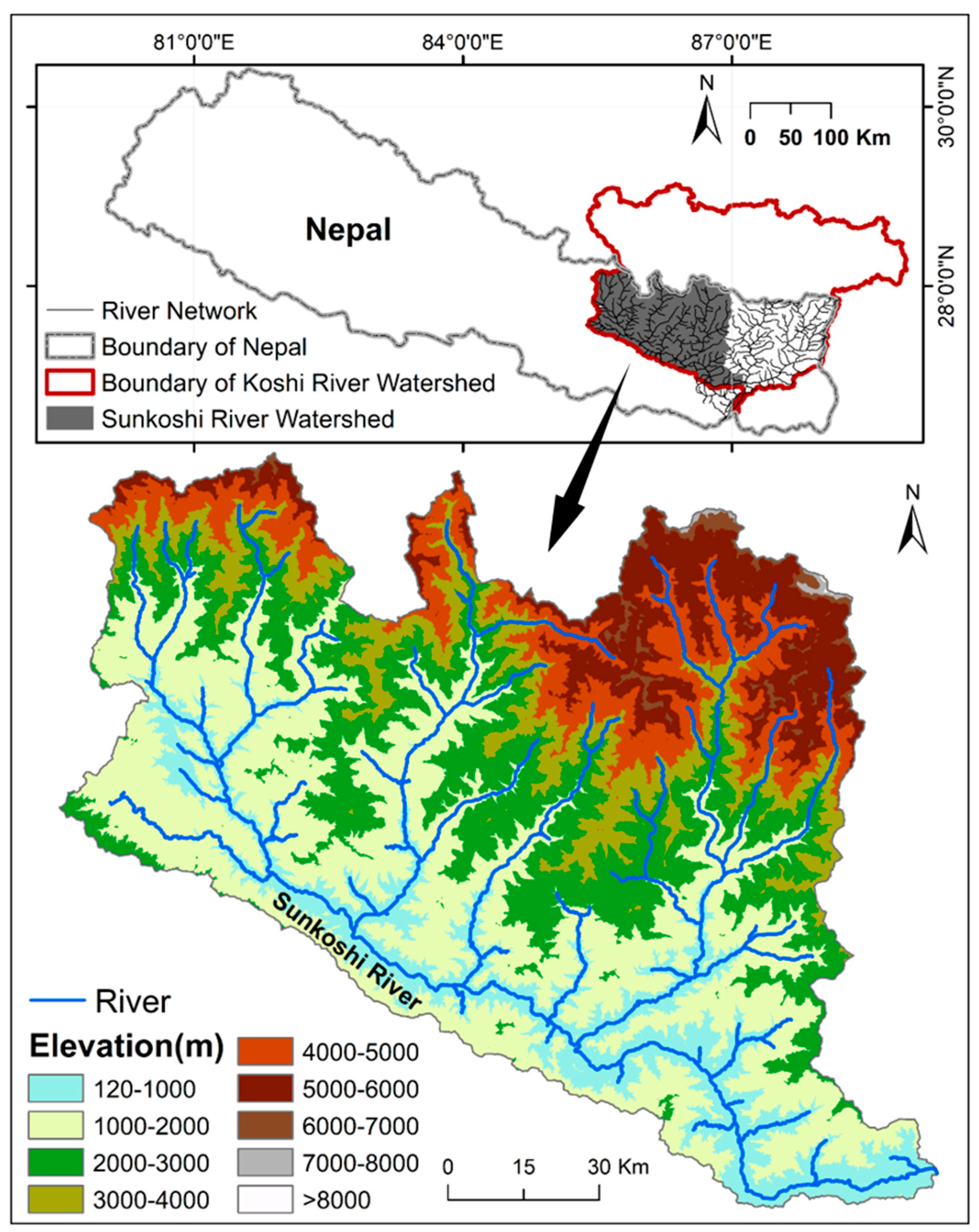
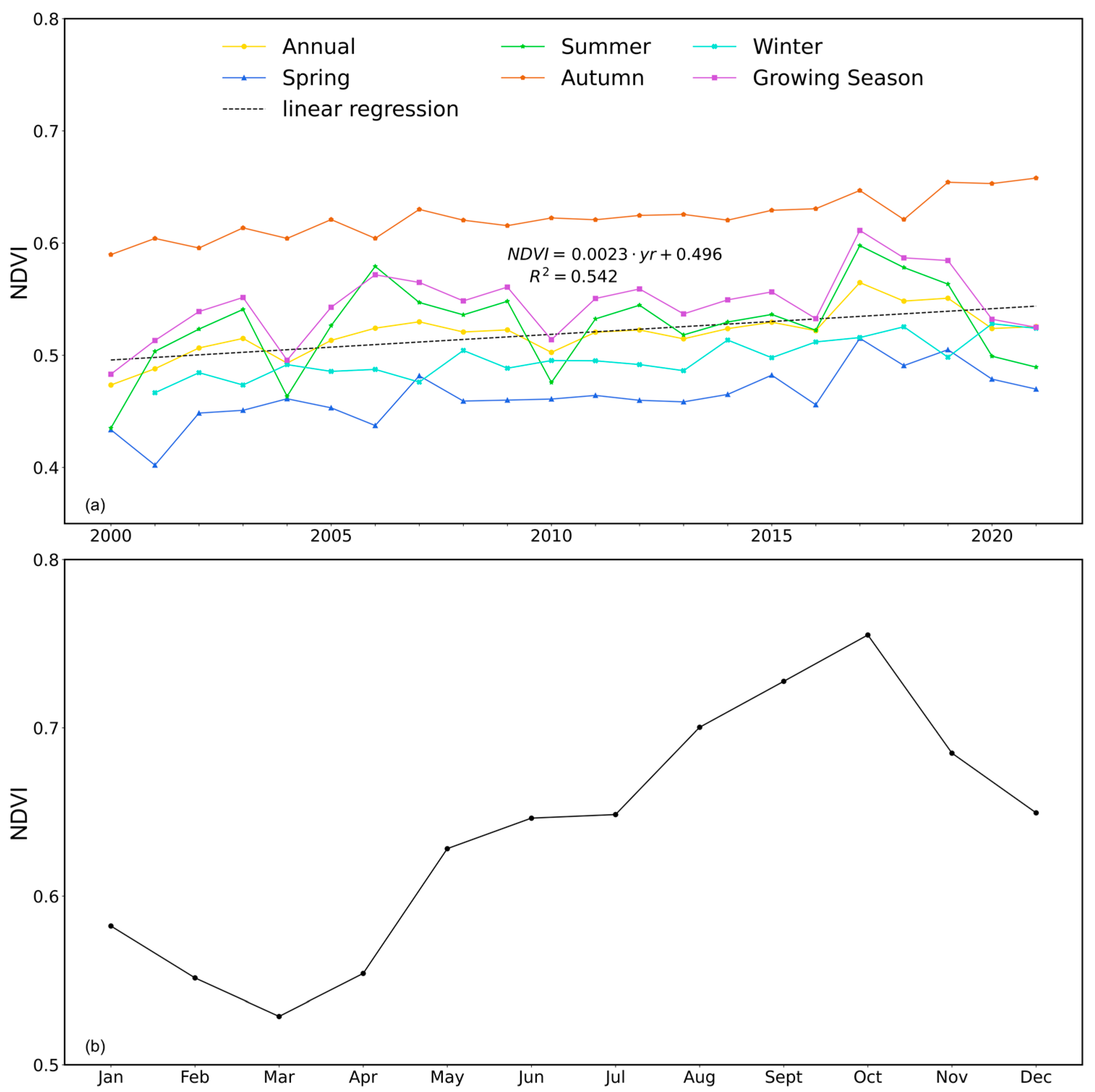
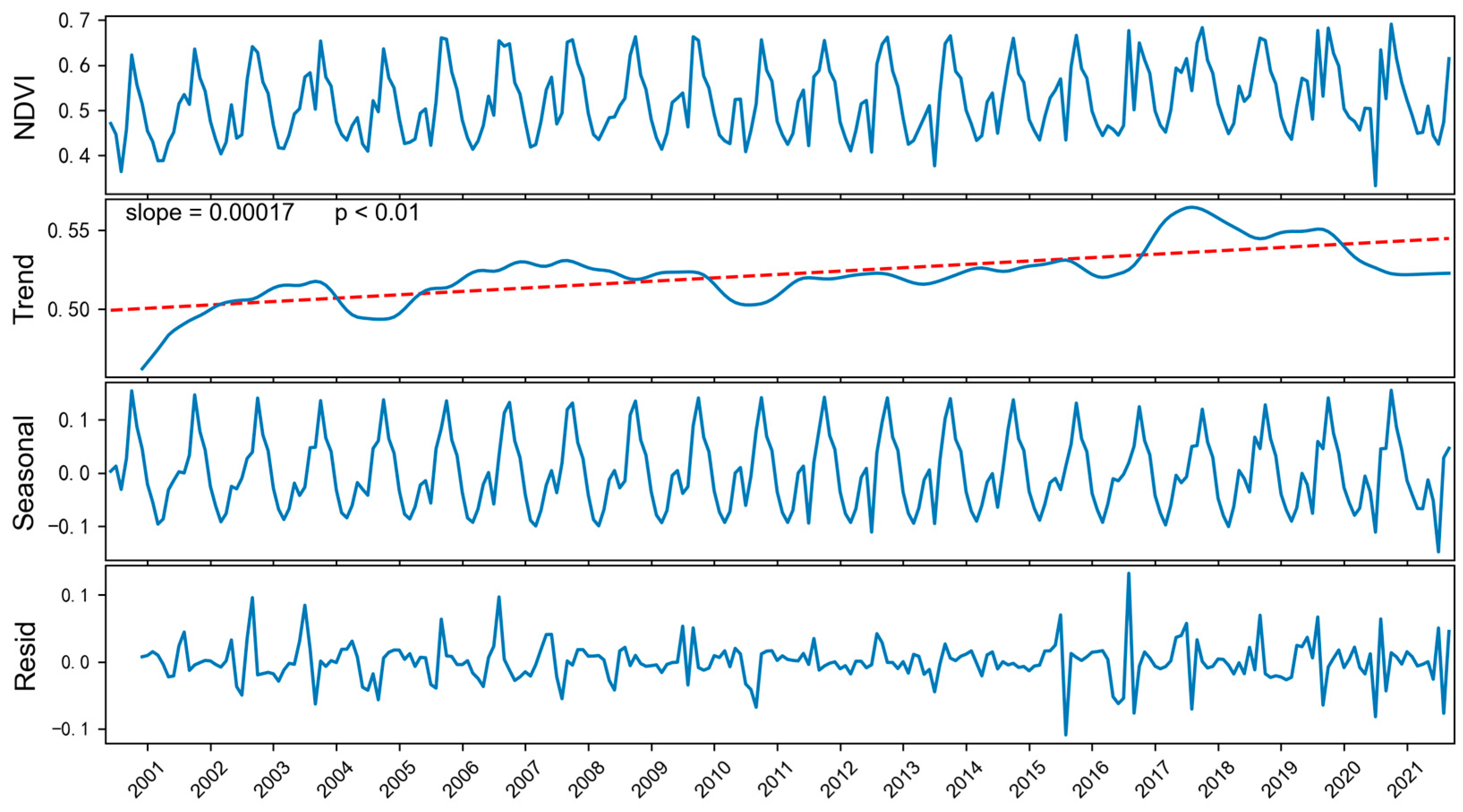

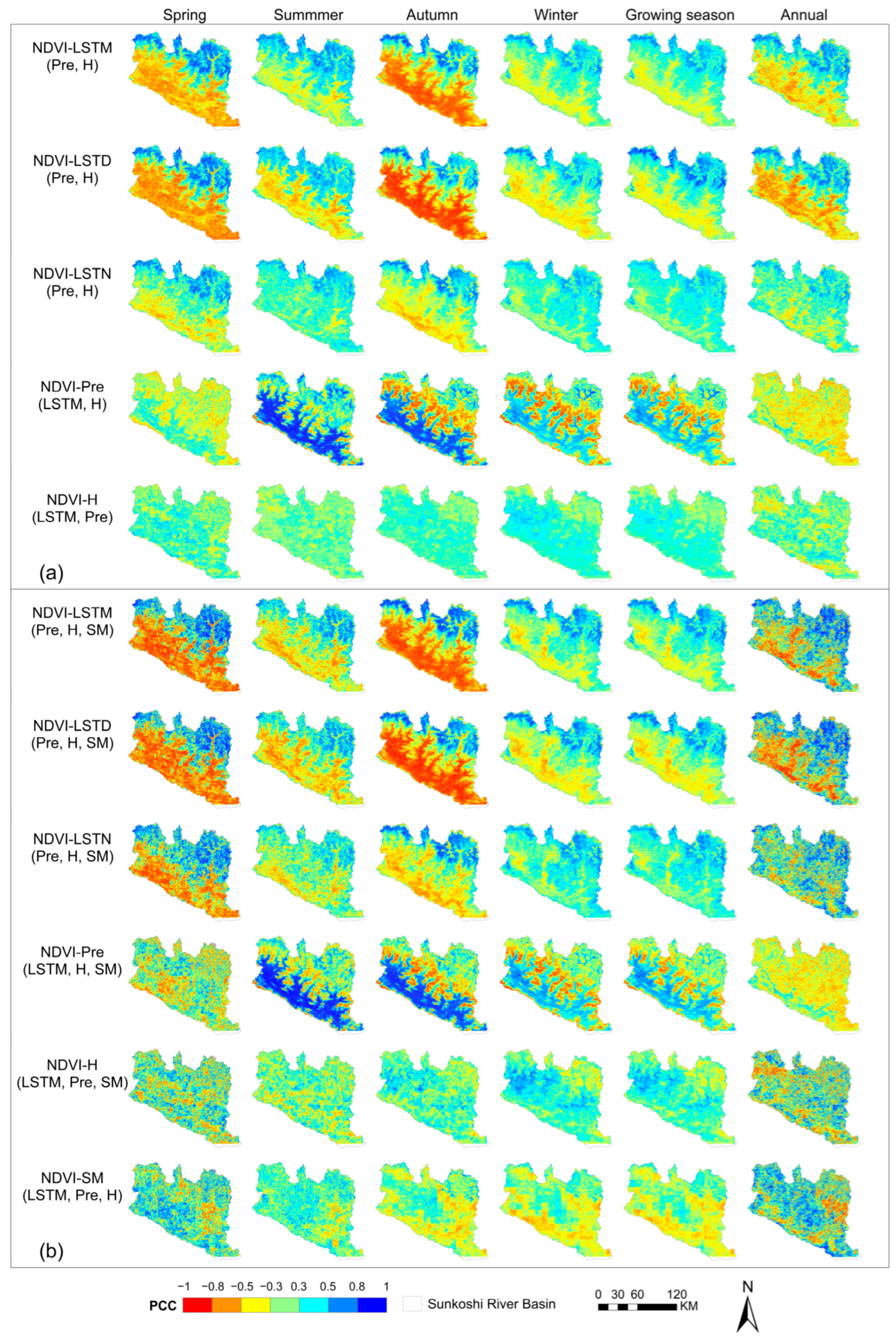
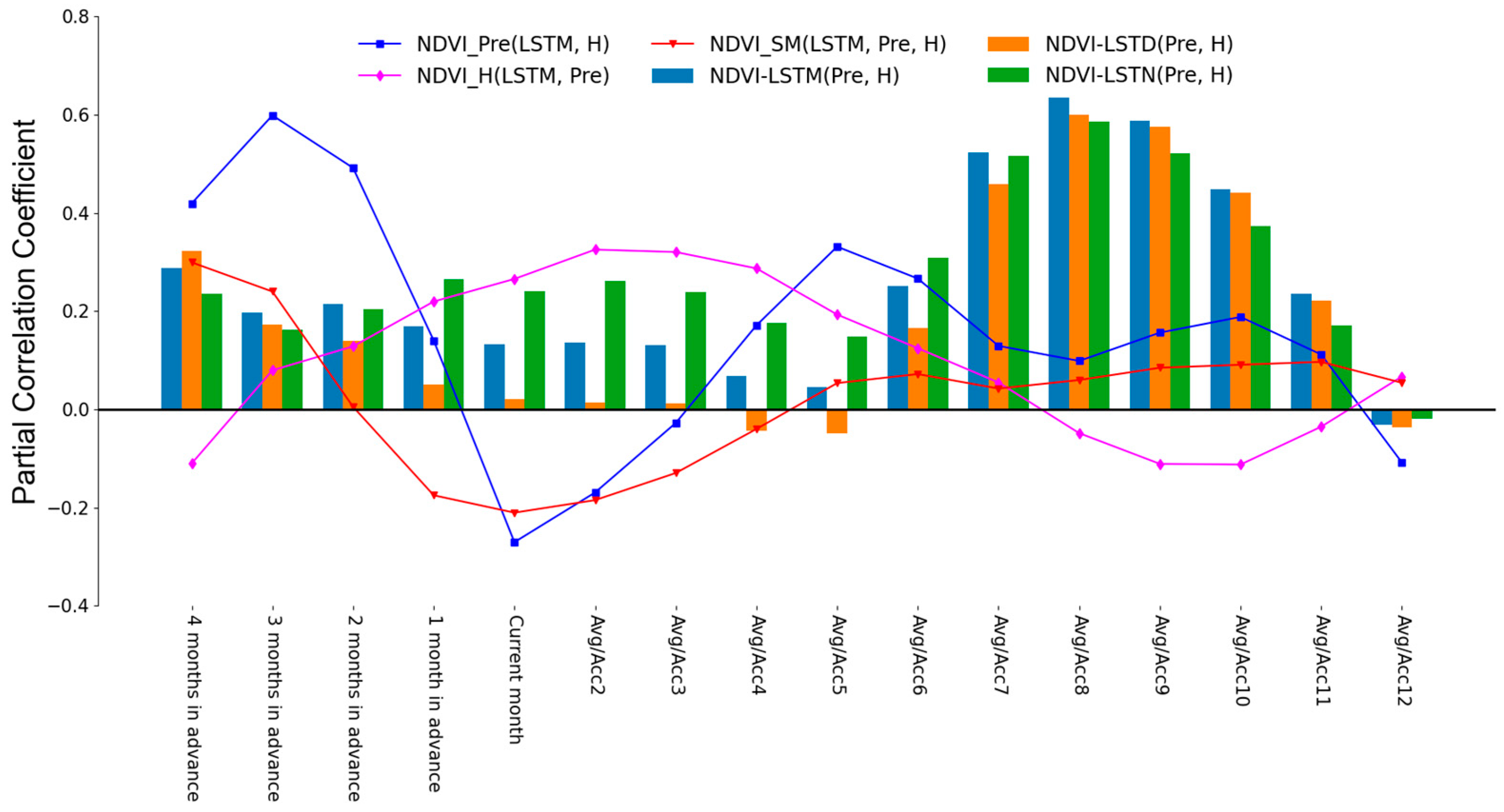
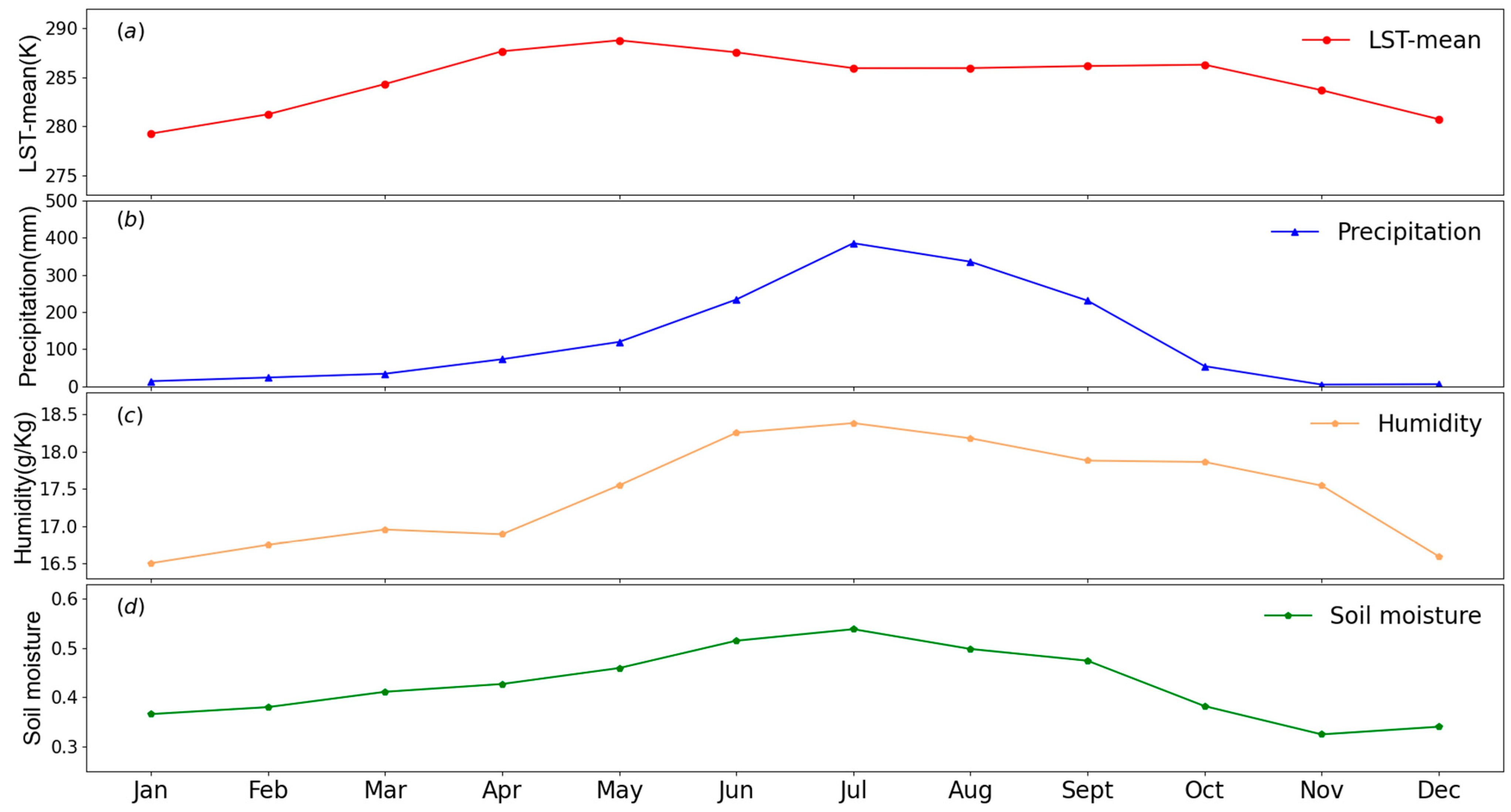
| Spring | Summer | Autumn | Winter | Growing Season | Annual | |
|---|---|---|---|---|---|---|
| Change rate (/year) | 0.0027 ** | 0.0114 | 0.0023 ** | 0.0024 ** | 0.0021 * | 0.0023 ** |
| Improvement | Degradation | |||||||
|---|---|---|---|---|---|---|---|---|
| High Sig. | Weak Sig. | Non-Sig. | Sum | High Sig. | Weak Sig. | Non-Sig. | Sum | |
| Spring | 33.6% | 12.5% | 40.3% | 86.4% | 0.2% | 0.1% | 13.3% | 13.6% |
| Summer | 8.3% | 9.8% | 62.4% | 80.5% | 0.4% | 0.1% | 19.0% | 19.5% |
| Autumn | 45.5 | 13.6% | 32.9% | 92.0% | 0.3% | 0.1% | 7.6% | 8.0% |
| Winter | 45.6 | 10.6% | 30.0% | 86.2% | 1.1% | 0.8% | 11.9% | 13.8% |
| Growing Season | 13.8 | 13.2% | 58.6% | 85.6% | 0.3% | 0.1% | 15.5% | 15.9% |
| Annual | 38.6 | 14% | 38.3% | 90.9% | 0.5% | 0.4% | 8.2% | 9.1% |
| NDVI-LSTM (Pre, H) | NDVI-LSTD (Pre, H) | NDVI-LSTN (Pre, H) | NDVI-Pre (LSTM, H) | NDVI-Pre (LSTD, H) | NDVI-Pre (LSTN, H) | NDVI-H (LSTM, Pre) | |
|---|---|---|---|---|---|---|---|
| Spring | −0.299 | −0.482 | 0.111 | −0.125 | −0.115 | 0.031 | 0.344 |
| Summer | 0.589 | 0.658 | 0.372 | −0.085 | −0.134 | −0.149 | −0.361 |
| Autumn | 0.048 | −0.067 | 0.188 | −0.165 | −0.2 | −0.097 | 0.322 |
| Winter | −0.361 | −0.525 | −0.129 | −0.432 | −0.432 | −0.272 | 0.089 |
| Growing Season | 0.288 | 0.217 | 0.255 | −0.389 | −0.416 | −0.382 | −0.210 |
| Monthly | 0.133 | 0.02 | 0.241 | −0.271 | −0.304 | −0.382 | −0.210 |
| Seasonal | 0.093 | −0.047 | 0.299 | −0.056 | −0.059 | −0.193 | −0.208 |
| Annual | −0.165 | −0.369 | 0.152 | −0.564 | −0.550 | −0.463 | 0.092 |
| NDVI-LSTM (Pre, H, SM) | NDVI-LSTD (Pre, H, SM) | NDVI-LSTN (Pre, H, SM) | NDVI-Pre (LSTM, H, SM) | NDVI-H (LSTM, Pre, SM) | NDVI-SM (LSTM, Pre, H) | |
|---|---|---|---|---|---|---|
| Spring | −0.212 | −0.357 | 0.164 | 0.009 | −0.009 | 0.234 |
| Summer | −0.096 | −0.167 | −0.058 | 0.100 | 0.085 | 0.322 |
| Autumn | −0.655 | −0.716 | −0.315 | −0.473 | 0.697 | 0.261 |
| Winter | −0.176 | −0.314 | 0.036 | −0.31 | 0.571 | −0.055 |
| Growing Season | −0.122 | −0.249 | 0.072 | −0.223 | 0.523 | −0.131 |
| Monthly | 0.216 | 0.091 | 0.368 | 0.204 | −0.330 | −0.417 |
| Seasonal | 0.256 | 0.154 | 0.327 | −0.058 | 0.199 | −0.211 |
| Annual | 0.487 | 0.319 | 0.610 | −0.785 | −0.057 | 0.681 |
Disclaimer/Publisher’s Note: The statements, opinions and data contained in all publications are solely those of the individual author(s) and contributor(s) and not of MDPI and/or the editor(s). MDPI and/or the editor(s) disclaim responsibility for any injury to people or property resulting from any ideas, methods, instructions or products referred to in the content. |
© 2025 by the authors. Licensee MDPI, Basel, Switzerland. This article is an open access article distributed under the terms and conditions of the Creative Commons Attribution (CC BY) license (https://creativecommons.org/licenses/by/4.0/).
Share and Cite
Jian, Z.; Yang, Q.; Shao, J.; Wang, G.; Pandey, V.P. Spatiotemporal Variation in NDVI in the Sunkoshi River Watershed During 2000–2021 and Its Response to Climate Factors and Soil Moisture. Water 2025, 17, 2232. https://doi.org/10.3390/w17152232
Jian Z, Yang Q, Shao J, Wang G, Pandey VP. Spatiotemporal Variation in NDVI in the Sunkoshi River Watershed During 2000–2021 and Its Response to Climate Factors and Soil Moisture. Water. 2025; 17(15):2232. https://doi.org/10.3390/w17152232
Chicago/Turabian StyleJian, Zhipeng, Qinli Yang, Junming Shao, Guoqing Wang, and Vishnu Prasad Pandey. 2025. "Spatiotemporal Variation in NDVI in the Sunkoshi River Watershed During 2000–2021 and Its Response to Climate Factors and Soil Moisture" Water 17, no. 15: 2232. https://doi.org/10.3390/w17152232
APA StyleJian, Z., Yang, Q., Shao, J., Wang, G., & Pandey, V. P. (2025). Spatiotemporal Variation in NDVI in the Sunkoshi River Watershed During 2000–2021 and Its Response to Climate Factors and Soil Moisture. Water, 17(15), 2232. https://doi.org/10.3390/w17152232






